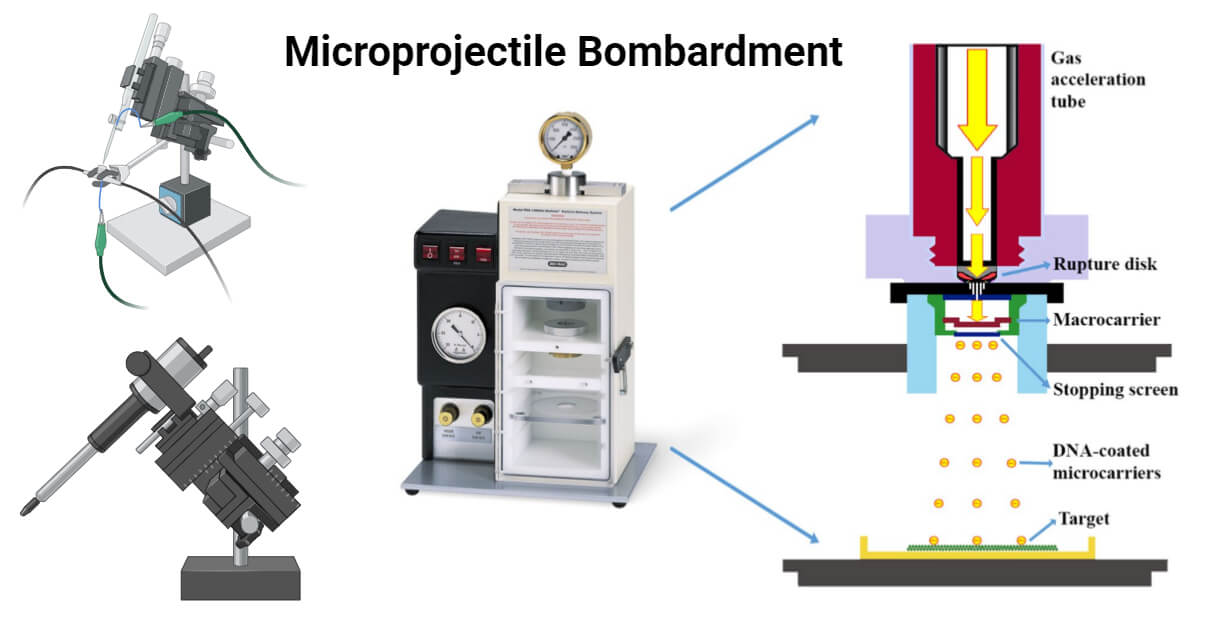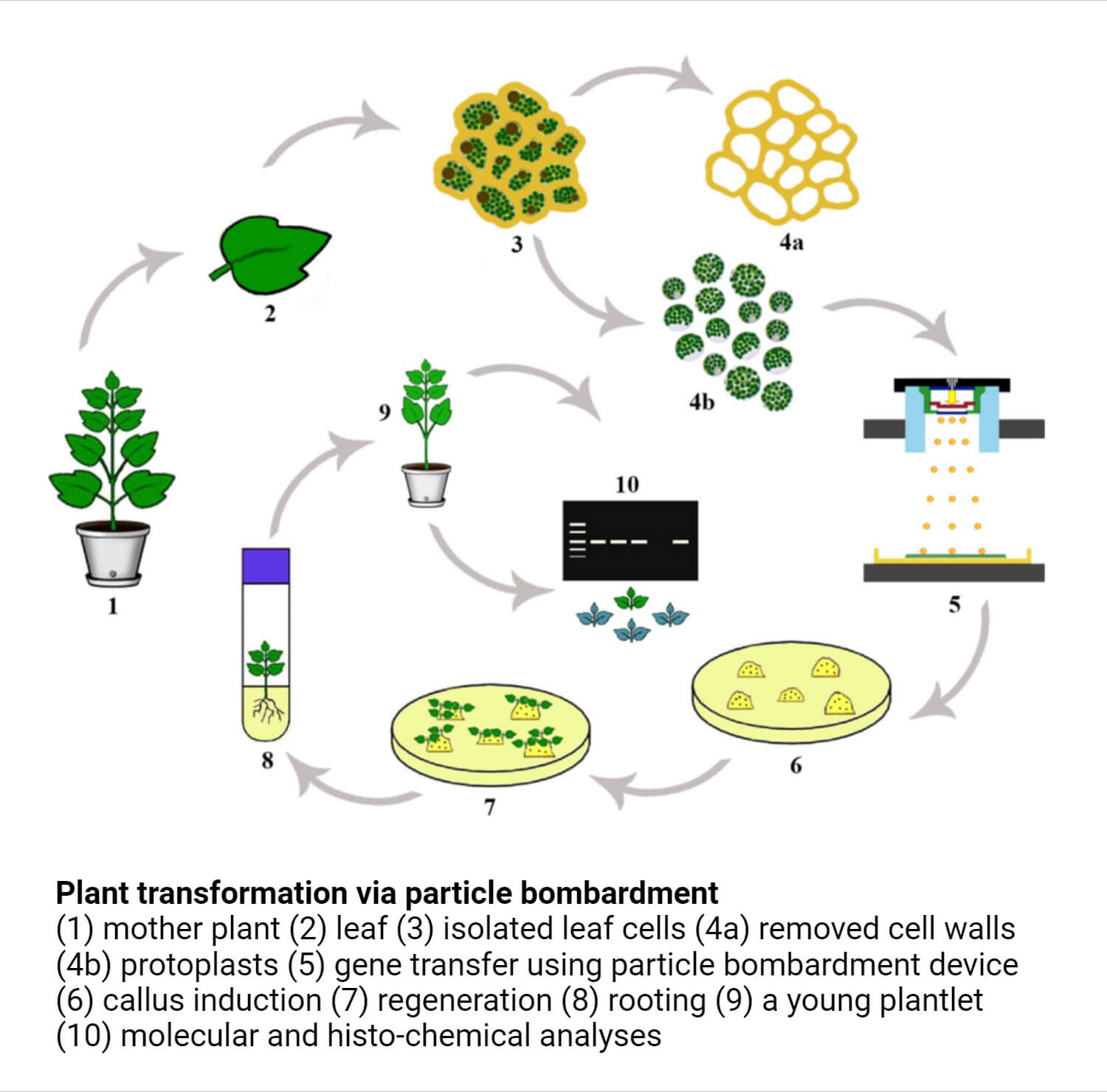Microprojectile Bombardment is one of the physical methods of gene transfer used to introduce foreign genetic materials directly into cells or tissues using high-velocity particles.
The method is known by alternative names, including Particle Bombardment, Particle Gun, Ballistics, and Particle Acceleration.

John Sanford and Ed Wolf developed the concept of microprojectile bombardment. This technique was initially developed for plant cell transformation and later adapted for mammalian cells.
Interesting Science Videos
Principle of Microprojectile Bombardment
The main principle of the microprojectile bombardment method is to deliver genetic materials directly into target cells by bombarding them with microcarrier particles at high velocity. The microcarrier particles, usually gold or tungsten, are coated with the genetic material of interest. They are inserted into the target cells using a high-velocity stream generated by either an electric discharge or helium pulse.
The high-velocity stream shoots the microcarrier particles toward the target cells, allowing them to penetrate the cell membrane and enter the cytoplasm. Once inside the cells, the genetic material separates from the microcarrier particles and can be used by the cell’s machinery for gene expression.
Microprojectile Bombardment Instruments
Different types of gene guns have been developed for microprojectile bombardment.
- Initially, first-generation microprojectile bombardment devices used gunpowder to propel microcarriers coated with desired genetic material.
- Gunpowder systems were replaced by high-pressure helium for particle acceleration. This helium-driven system significantly improved transformation efficiency.
- Advancements in technology have led to the development of improved gene guns that use different propulsion forces such as electrostatic, pneumatic, and compressed gas.
- There are two devices widely used for microprojectile bombardment: the PDS-1000/He and the Helios gene gun.
- The PDS-1000/He uses helium gas to accelerate microscopic gold or tungsten particles coated with genetic material toward the target tissue. The Helios gene gun is a handheld device for transforming larger target tissues. Both devices use pressurized helium to propel microcarriers coated with genetic material.
Steps in Microprojectile Bombardment
- The process begins by preparing the microcarrier particles for coating with the genetic material of interest. The microcarrier particles are usually made of gold or tungsten.
- Then, the desired genetic materials are coated onto the surface of the microcarrier particles.
- Once the microcarrier particles are coated, they are loaded into the gene gun device. The gene gun shoots out particles at a high velocity using a strong pulse of pressurized helium.
- When the pressure inside the gene gun reaches a critical level, the rupture disk bursts, creating a strong wave of gas. This wave pushes the macrocarrier that contains microcarrier particles toward the target cell. The macrocarrier hits the stopping screen. The stopping screen prevents the passage of the macrocarrier but allows the coated microcarrier to pass through it.
- The target cells are placed under a vacuum in the main chamber of the gene gun. The cells are placed on a petri dish or culture plate.
- When the high-velocity particles reach the target cells, they penetrate the cell membrane and enter the cytoplasm.
- After the microcarrier particles reach the target cells, the genetic material of interest separates from the microcarrier particles. Once separated, the genetic materials can be used by the cell’s machinery, leading to the expression of the genes.
Applications of Microprojectile Bombardment
Some major applications of microprojectile bombardment are:
- Microprojectile bombardment is widely used for introducing foreign genes into plant cells and producing genetically modified plants with improved traits such as disease resistance and higher yield.
- Microprojectile bombardment has also been used to generate transgenic animals with specific desired traits.
- This method of gene delivery allows the study of gene function and expression patterns in different tissues.
- This method also has applications in gene therapy for delivering therapeutic genes directly into target tissues to treat genetic disorders, cancer, and other diseases.
- Microprojectile bombardment can also be used to develop DNA vaccines by delivering DNA-encoding antigens directly into cells.
- It can also be used to deliver fluorescent dyes into cells and tissues to study cellular signaling processes.

Advantages of Microprojectile Bombardment
- It is a fast and relatively simple method for delivering desired genetic materials into cells.
- It can be used to deliver large nucleic acid fragments.
- This method is not dependent on host specificity or species limitations.
- It is a safer method for genetic transformation as it doesn’t require the use of harmful viruses or toxic chemicals as gene delivery vehicles.
- Unlike other methods that need the cell wall to be removed, gene gun delivery can penetrate the intact cell wall. This simplifies the process and can be used to transform a wider range of cells.
Disadvantages of Microprojectile Bombardment
- This method requires specialized equipment. The initial investment for the required equipment and materials can be costly.
- The target cells may experience physical damage due to the high-velocity particles leading to reduced cell viability.
- When using the gene gun method on a larger scale, its effectiveness tends to decrease.
- Another limitation is that the introduced DNA can randomly integrate into the host genome. This can result in unpredictable patterns of gene expression.
References
- Baltes, N. J., Gil-Humanes, J., & Voytas, D. F. (2017). Genome Engineering and Agriculture: Opportunities and Challenges. Gene Editing in Plants, 1–26. doi:10.1016/bs.pmbts.2017.03.011
- Carter, M., & Shieh, J. (2015). Gene Delivery Strategies. Guide to Research Techniques in Neuroscience, 239–252. doi:10.1016/b978-0-12-800511-8.00011-3
- Do Minh, A., Sharon, D., Chahal, P., & Kamen, A. A. (2019). Cell Transfection. Comprehensive Biotechnology, 383–390. doi:10.1016/b978-0-444-64046-8.00023-9
- https://biologyreader.com/microprojectile-bombardment.html
- Jinturkar, K. A., Rathi, M. N., & Misra, A. (2011). Gene Delivery Using Physical Methods. Challenges in Delivery of Therapeutic Genomics and Proteomics, 83–126. doi:10.1016/b978-0-12-384964-9.00003-7
- Matsumoto, T. K., & Gonsalves, D. (2012). Biolistic and other non-Agrobacterium technologies of plant transformation. Plant Biotechnology and Agriculture, 117–129. doi:10.1016/b978-0-12-381466-1.00008-0
- Ozyigit, I. I., & Yucebilgili Kurtoglu, K. (2020). Particle bombardment technology and its applications in plants. Molecular Biology Reports. doi:10.1007/s11033-020-06001-5

Very simple and easy to understand